10.22.21What’s New in 3.0? A Summary for Readers

Lots of questions from teachers and school leaders about TLAC 3.0. What’s new about it? If I’ve got 2.0 already, is 3.0 worth the trouble?
IMO it is, obviously. The new version includes five years worth of further insight…insight that’s shaped by amazing teachers and my incredible team of colleagues. But you’re right to want more specifics than that so here’s a brief guide to What’s New in TLAC 3.0:
Two completely new chapters:
One of the key themes of the new version of the book is decision-making. My goal was to support teachers in using the techniques effectively, to choose and adapt the right move at the right time. A big part of that is having a larger mental model of how learning happens. Chapter 1 endeavors to provide that. It describes five key ideas teachers should always be thinking about to maximize learning and discusses how they influence instructional choices. The first idea is the differing roles of Working and Long-term Memory; the second is the power of habits to ‘hack working memory” and allow students to focus on the important things; the third is the pervasive importance of “selective attention”–guiding what students focus on and think about; the fourth is student motivation- the ways it is profoundly social and why students’ perceptions of classrooms norms is so important; the fifth is the importance of relationships- my discussion focuses on it in ways that some teachers might find surprising: for example the adage that students ‘won’t care about what you teach until they know that you care’ is deceptive because teaching students well is one of the most effective ways to show you care about them.
Chapter 2, also brand new, is about preparation, which is different from planning. Planning focuses on what you’ll teach and preparation on how. For example, if you are teaching the same lesson to your third period class and your fifth period class and one group is reluctant and reserved and one energetic and sometimes prone to getting carried away, you would prepare the same lesson differently– you’d want to draw third period out a bit and focus fifth period when necessary. That would mean different tools. You’d prepare differently. I also apply the ideas from chapter 1. One of the best ways to be “present” when students answer your questions, for example, and to hear what they say accurately, is to clear your own working memory by writing out an ‘exemplar’–an ideal student answer–and keeping it with you during the lesson.
Extensive discussion of research connecting the techniques to cognitive and social sciences:
This has been as long time coming. I’ve always seen the techniques I’ve learned from teachers as being aligned to what the science tells us but I haven’t been explicit enough in sharing those connections and teachers were right to ask for it. In this version of the book I’ve tried t do that much more explicitly.
Extensive discussions and reflections on the book’s place in the larger context of an emphasis on diversity, equity, and inclusion:
Again teachers are right to have questions. The new version of the book starts with a preface that explains what my team and i believe about a just and equitable classroom and how schools can and must pursue those aims. I want teachers whose version of social justice includes holding high expectations for the students we love to feel clear and confident about how to accomplish that. And it’s a topic I take up extensively throughout. Many of the techniques are almost twice as long as they were previously so I could explain the connection more clearly. In some cases I re-named techniques to make their emphasis and purpose clearer and to prevent misapplications and misunderstandings that might come at a cost to students.
“Keystone” videos:
One long standing challenge of using video to demonstrate teaching techniques is that it can distort them even while it displays them. You show a series of small moments in sharp detail and it’s easy to miss all of the other things that might happen around them during class. In this version of the book I’ve included more than a dozen longer running clips that show ten minutes or so of a teacher’s lesson, relatively uncut, so you can see how the techniques fit together and build a larger ethos of love and rigor. These are also ideal for master teachers to use to refine their own style and decision-making in the classroom.
A dozen new techniques
The 3.0 version has gone from 62 to 63 techniques but don’t be fooled. Sprinkled throughout are more than a dozen new techniques. They include a few, like Retrieval Practice and Knowledge Organizers, that help teachers use background knowledge more effectively. There are several such as Phrasing Fundamentals and Means of Participation that help teachers ask questions more productively. And of course the Lesson Preparation Chapter includes several new techniques. Among them Exemplar Planning, an idea developed by Paul Bambrick, has been especially popular.
Add to that full rewrites of your favorite techniques such as No Opt Out, Cold Call and Joy Factor and more than 100 new videos and you’ve got a book that I think represents a major advance over the 2.0 version.